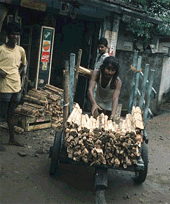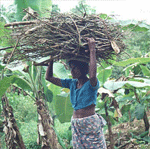:: Specific Design Brief
Practical Action 5:
Sustainable
Cooking - further information
PRODUCT DESIGN SRI LANKA
- ENERGY SOURCES
 Sources of energy in Sri Lanka
Sources of energy in Sri Lanka
Finding a sustainable source of energy, especially for cooking is a major
concern for the majority of the population in Sri Lanka. Biomass energy
(plant materials, including wood, and animal waste used for fuel) is used by
more than 80% of the population. Research suggests that although other forms
of energy are slowly becoming available, biomass will remain the main source
of energy for the poor.
At the start of the 21st century the average consumption per person in Sri Lanka
was about 1.3kgper day, whilst in colder and hilly areas it went up to 2.5 kg.
The total national consumption is estimated to be about 10 million tons
annually. Although there is a variety of potential sources of biomass (coconut
plantations, forest, crop land, processing waste and home gardens), firewood is
used a great deal. There are alternatives, kerosene and liquid petroleum gas,
but these are often beyond the income of poorer families who can usually find
firewood or alternative biomass sources freely available. It is estimated that
10% - 15% of the firewood comes from forests or cotton and tea plantations, home
gardens and crops. Packs of firewood are sold in shops and by the roadside. They
cost around 50 rupees (about 35p).
Problems with biomass collection
Reliance on biomass creates issues both environmentally and socially. Demand for
firewood means a constant search for good sources which means loss of forest
with consequent environmental and climate changes.
It is usually Sri Lankan women who take responsibility for the collection of biomass. This takes time and means their ability to do other more productive roles is severely restricted. When there are shortages, the problem becomes more acute. They have to travel longer distances to collect firewood, or they reduce the number of meals cooked, or they use lower quality (e.g. wet) biomass for cooking. Sometimes, they ask school-age children to collect instead, or go into prohibited areas in search of wood. At times of shortage, they are also likely to stop any income-generating activities (e.g. making curd) in order to concentrate on keeping the family properly fed, which means collecting firewood daily.
The process of collecting is in itself sometimes hazardous. There is reduced
infant and child care, possibility of snake or insect bites, severe tiredness
and allergies from fungi in the forests.
Problems with using firewood as an energy source
It is not just the supply of biomass that creates problems for families,
especially women. Using biomass, especially indoors, creates health hazards.
Fires are usually located in the kitchen, the heart of family life where
children and women spend most of their time. Smoke is a major problem. Since the
fires have no hoods, and often the kitchens have poor ventilation, respiratory
problems, conjunctivitis, bronchitis, pulmonary diseases and even cancer are
potential outcomes.
The fires themselves are also hazardous. They are
often at ground level and therefore easily accessible to small children, making
burns an obvious problem. Crouching to attend the fires also leads to back
problems.
Finally, there is the question of loss of forests. Because demand is so high,
and the most common type of fire is an open three-stone fire, there is
considerable waste of energy through the difficulty of controlling the heat in
an open fire.
�
FURTHER INFORMATION
METHODS
�